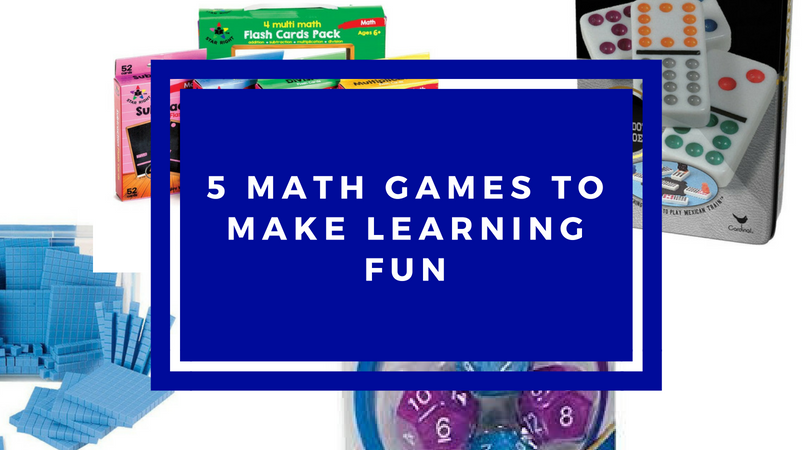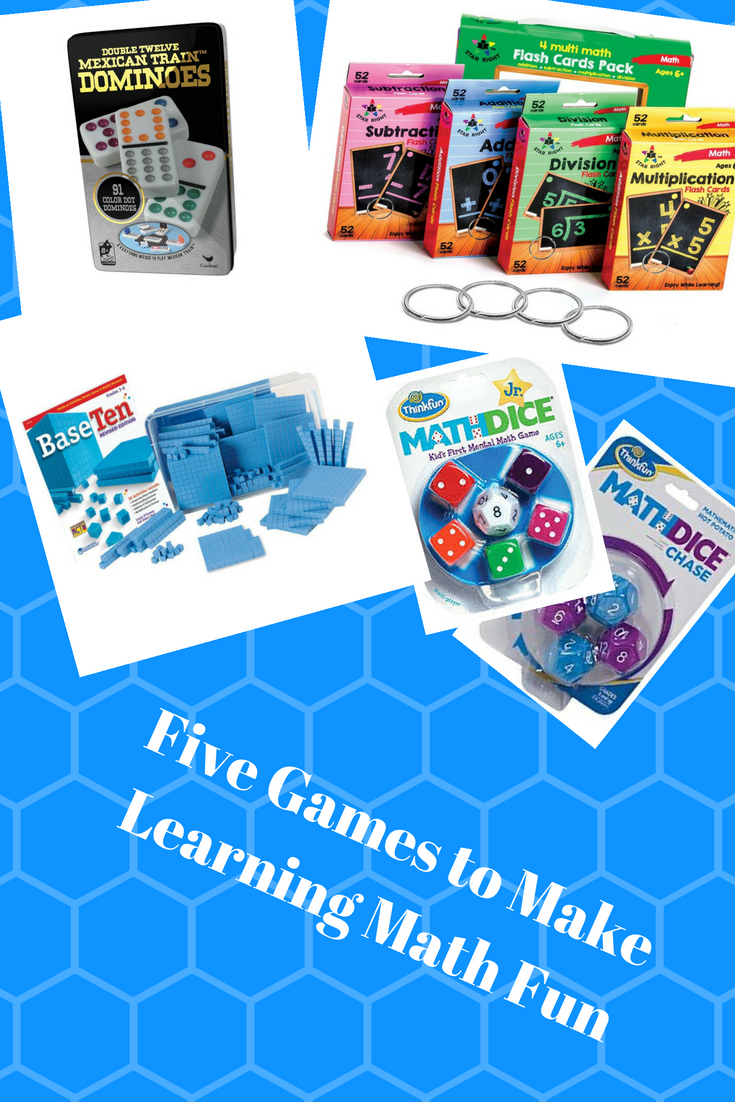5 Math Games to Make Learning Fun
Math is all around us. For those of us who love it, math can feel like a never-ending puzzle. For those of us who don’t understand it, it can feel like a recurring nightmare. We are trying to run away from the villain but somehow they always keep catching up to us. Math, however, can be fun for all through math games.
Like that shadow around the corner in movies that seems big and scary but ends up being a harmless bunny. One way to make math fun is through games. Below are some of my favorite math games. I hope that you and your students will find as much joy from them as I have.
*This post contains affiliate links for full disclosure click here
Increase Math Understanding With Math Games
According to the National Council of Teachers of Mathematics, “People of all ages love to play games that are fun and motivating. Games give students opportunities to explore fundamental number concepts, such as the counting sequence, one-to-one correspondence, and computation strategies.
Engaging mathematical games can also encourage students to explore number combinations, place value, patterns, and other important mathematical concepts. Further, they afford opportunities for students to deepen their mathematical understanding and reasoning.”
Games are games because they are fun. They open up doors for students that may not like math otherwise. There is plenty of simple games that you can play around the dinner table, or in tutoring sessions that will help math stick in your student’s heads. All of the games that follow can be adapted to work with basic math concepts like addition, subtraction, multiplication, and division.
1) Math Dice
There are three awesome versions of this simple dice game. There is Math Dice Jr., Math Dice, and Math Dice Chase.
Math Dice Jr. comes with five six-sided dice and one 12 sided die. This game is made specifically to be used with addition and subtraction. The students roll the 12 sided die to see the target number. They then roll the five 6 sided dice and use addition or subtraction to reach the number on the target die with at least two of the smaller dice. To up the challenge make students use more of the dice, or add the ability to use multiplication and division. This can be easily adapted to teach multi-step problems. Are you working on word problems? Make your students come up with a word problem to go with the numbers on the dice.
Math Dice comes with two 12 sided dice and three six-sided dice. This game is played by rolling the two 12 sided dice and multiplying them to get the target number. Students then roll the three smaller dice and try to use the numbers on them with any equation to get to the target number. This can also be adapted to work with division by making student multiply the two 12 sided dice to get the target number and then using the target number divided by the number on one of the dice. This helps them learn the link between multiplication and division. One could also teach factoring by having students give the factors of the target number.
Lastly, there is Math Dice Chase. This is advertised as the math version of the classic game hot potato. In Math Dice, Chase speed is the name of the game. It comes with two blue 12 sided dice and two purple 12 sided dice. Students compete with other students by rolling two of the dice at a time and solving the multiplication problem. If you get it wrong or are stuck with the dice when the music stops you’re out. This is more ideal for bigger groups of students but it can be used in smaller groups with a little different gameplay, in which the goal is just to solve the multiplication problems.
I have used dice to teach multiplication to my students and they have much more fun when they are playing with the dice then when they are just doing worksheets. It makes math visual and hands-on for them. It also makes it seem not like work but a time to interact with each other. For littles dice can be used to teach them how to count. Dice games will also set a foundation for addition in kindergarten and 1st grade.
2) Multiplication.com
Multiplication.com has been a lifesaver for many of my students over the last six years. I usually start introducing multiplication topics to my 2nd graders through multiplication.com. There are tons of virtual multiplication games, and I have seen my students thrive in later grades because of the work that they put in on multiplication.com. The good news is that it didn’t even feel like work to them. All third graders should know all of their multiplication tables. If they don’t it will be 100% harder for them to keep up with math down the line. I have seen upper-level students severely struggle with math because they do not have a good foundation on multiplication. Some of my favorite games on multiplication.com are Fish Shop, Cone Crazy, and Penguin Jump. They also have addition, subtraction, and division games. So this site can be helpful for all elementary students.
Want to Read More?
5 Ways to Teach Math Using Couponing
Back to School Autism Transition Strategies
Stop the “Reading is Boring” Excuse
3) Flashcards
Sometimes the classics are the best. My mom was a big fan of flashcards, which probably explains why to this day I am also a fan. My mom often would pull out the flashcards at the dinner table or on long car trips. My brother and I would then compete to see who could answer faster. Sometimes we played this also with my cousins or other family members. I usually beat them because they were not used to playing like I was. With flashcards, the repetition of playing helps the students memorize the concepts. This makes it so the longer they play the easier it is for them. You can find flashcards for almost any concept in math but they work particularly well with addition, subtraction, multiplication, and division.
4) Base 10 set
Any teacher who has worked with elementary schoolers is probably familiar with Base 10 sets. These are blue sets of unit cubes. There are ones is one unit cube. Rods are 10 unit cubes. Flats are 100 unit cubes and a cube which is 1000 unit cubes. These sets are used to help students learn place value. They are also helpful for addition, subtraction, multiplication, and division.
The awesome thing about this set, which I found on Amazon, is that it has an activity book with many activities for a base 10 set. It also has a storage box, which is so needed! Anyone who has worked with a base 10 set knows that it can get everywhere. The ones are prone to just be all over the place instead of where they actually belong.
Another activity that I would suggest with these is for students to see how many different ways they can make the same number. It can be a competition to see who can get the most. You can also use this set to teach factors. A question you may ask is, “How many different factors are there for this number?” You can have students compete to see who can get the factors the fastest. For littles, you can use the base ten sets to count. They also may be ready to show you the same number in different ways.
5) Dominoes
Dominoes is a classic game of matching numbers. This in itself has benefits for math. The littles would be ready for this game in its original form because it will have them matching up numbers with alike numbers. However, this game can also be used to do higher level math as well.
Simple Math with Dominoes
Dominoes can be used for addition, subtraction, multiplication, or division. Students can add or subtract the numbers that are on each domino. Students could also multiply the numbers that are linked together to practice multiplying doubles. They could also multiply the numbers that are on the same domino.
Another way, that students can do simple math with dominoes is through a game called domino war. Domino war is quite like the actual game of war. All the dominoes are divided up among the players. The students then flip over their dominoes and add, subtract, or multiply the numbers (depending on the grade level of your students) The person with the highest number gets all the dominoes. In the case of a tie, those students who tied put out another domino and the process starts over again. If you lose all your dominoes you lose. If you collect all the dominoes you win.
Fractions with Dominoes
Dominoes are also great for working on fractions. The number on the top of the domino becomes the part of the faction and the bottom becomes the whole. Through this you can add, subtract, multiply, or divide fractions. This makes learning fractions a bit more fun and this fraction variant can be used with the games I mentioned above. For war, the student with the largest fraction would get the dominoes. In the original game when a student puts down a domino, they have to add, subtract, multiply, or divide their fraction with the fraction they put it next to. This makes the original game of dominoes more challenging, but it also makes it much more fun for the students and they may just learn it a little better.
Math can be difficult but games are usually always considered to be fun. Engaging students through math games is a good way to help them learn and practice math skills without it feeling like work. You may also have some fun playing as well.
*This post contains affiliate links. To buy the items click on them above or head over to my shop. I may receive revenue from purchases.
If you enjoyed this post please share it so that others can benefit as well. A great way to share is Pinterest.









I was one that hated math as a high school student because I didn’t understand where I was going to use it. I wanted to teach elementary children and didn’t think there was a use for Algebra 2. Making math fun through games and real-life applications is a better way to teach math.
Totally agree Stena. Math is better when you see how you will actually use it in life or when it is fun. I think that if we make math fun in elementary school that makes it easier when students get into upper level math. Then they are not as confused.